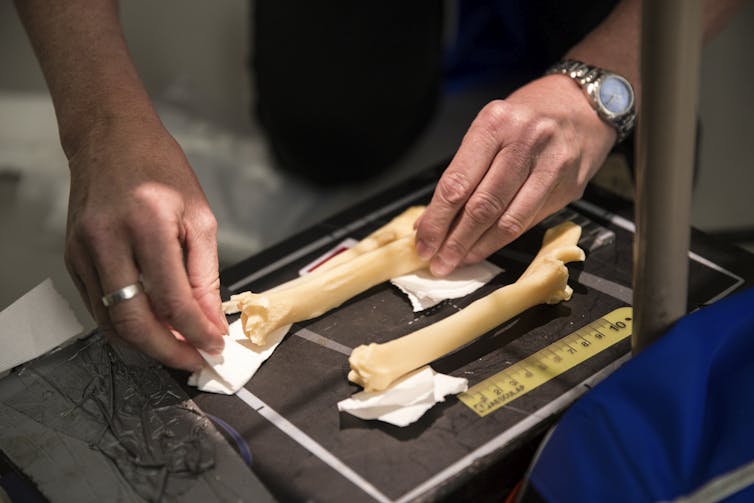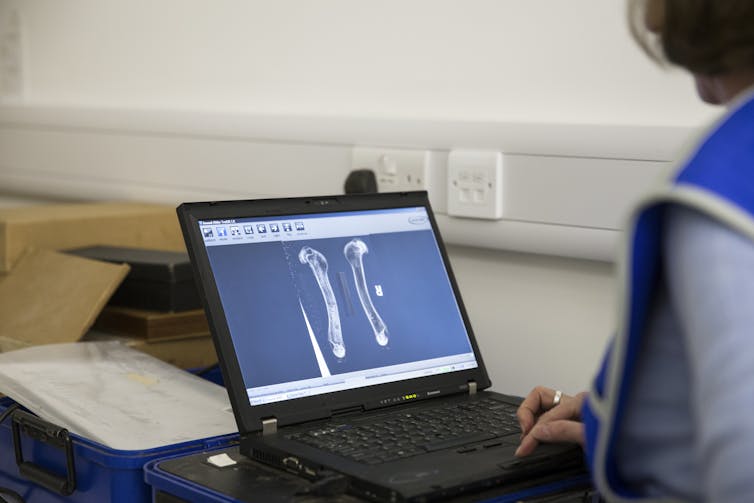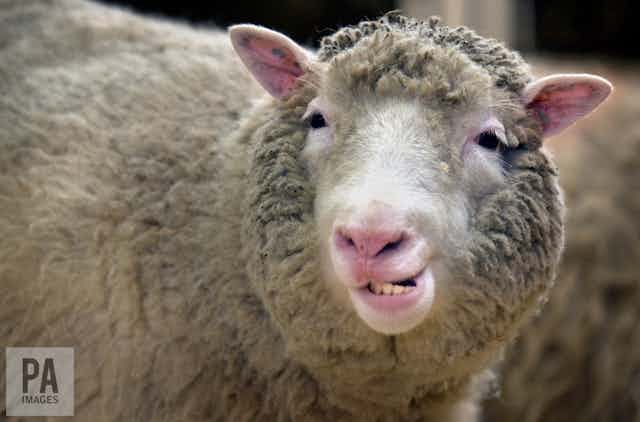Dolly the sheep was just six and a half years old when she died, over half the age most sheep live to. Yet despite her relative youth, she was also thought to be suffering from osteoarthritis, a disease usually found in much older sheep. Dolly was the first animal to be cloned from a fully grown adult, and some speculated that this meant her biological age (how old her DNA was) was effectively older than her chronological age (how long she had been alive).
Evidence that Dolly’s DNA was indeed older than that of similarly aged non-cloned sheep, and her diagnosis with early onset osteoarthritis at the age of five and a half seemed to confirm this.
But my colleagues and I have published new research that reveals Dolly, and other clones born around that time, showed no abnormal pattern of osteoarthritis after all. This is important because it means it should be possible to reprogram adult cells to be used for cloning without carrying over the legacy of ageing from the original organism. In short, clones may be like brand new organisms rather than copies of old ones.
Since Dolly’s birth in 1997, more than 20 animal species have been cloned using somatic cell nuclear transfer (SCNT), the process of turning adult cells into new embryos. A number of studies have investigated the health of cloned offspring but mostly looking at the loss of embryos during pregnancy and complications that occur around and shortly after the time of birth. Few studies were able to assess the long-term health implications of cloning and so we didn’t know whether or not clones suffered disproportionately from common, age-related diseases such as diabetes, heart disease and osteoarthritis.

Then in 2016, my colleagues and I assessed a group of 13 aged cloned sheep (eight to nine years of age), four of which were cloned from the mammary-gland cell line that gave rise to Dolly. These animals therefore were effectively clones of Dolly. We found only mild, and in one case moderate, evidence of osteoarthritis in these sheep following X-ray and MRI analyses.
None of these animals presented clinical symptoms of this disease and they were otherwise perfectly healthy. This led us to question the nature and extent of osteoarthritis in Dolly and whether or not cloning by SCNT contributed to this disease in Dolly.
New evidence
Unfortunately, X-ray records of Dolly’s osteoarthritis (taken some 16 years ago) were not preserved. They were limited, in any case, to records of just the left and right knee. Fortunately, Dolly’s skeleton and that of two other important cloned sheep (Megan and Morag) created at the University of Edinburgh’s Roslin Institute are kept by National Museums Scotland, which has an exhibit on Dolly. Dolly and Morag died prematurely after contracting a virus that causes lung tumours in sheep.
We made detailed X-ray analyses of the skeletons and that of Dolly’s first lamb (Bonnie) who was conceived naturally and lived for nine and a half years. We found that the nature and extent of osteoarthritis in Dolly was no different to that of the cloned sheep at Nottingham, nor was it different from similarly aged sheep conceived naturally.
X-ray evidence of osteoarthritis was greatest for Megan, who lived to 13 and a half (equivalent in human terms to someone in their 90s). In contrast, there was no evidence of osteoarthritis in her clone Morag, who died at four and a half.

From this evidence, we conclude the original concerns that cloning by SCNT had caused early-onset osteoarthritis in Dolly were unfounded. There are many other naturally occurring factors that could explain why Dolly, and not the Nottingham-Dolly clones, showed clinical signs of arthritis. Not least of which is the fact that Dolly produced six lambs in her lifetime, including a pair of twins and a set of triplets, whereas the cloned sheep at Nottingham were not bred.
This study, and the one we published last year on the health of the cloned animals, indicate you can produce perfectly normal and healthy animals using advanced breeding technologies such as SCNT. Although the number of animals we have produced in this way is small, they prove it is possible and so many more could follow.
Since the birth of Dolly, there has been considerable improvements in the overall efficiency of cloning by SCNT. Work in several countries continues to seek further improvements and it’s likely that issues associated with pregnancy losses and complications around the time of birth will be reduced further. Improvements of this nature could open up the possibility to, for example, use SCNT to create genetically modified animals that are resistant to certain diseases such as swine flu. This would help minimise the need for antibiotics and reduce the risk of transmission to humans.

